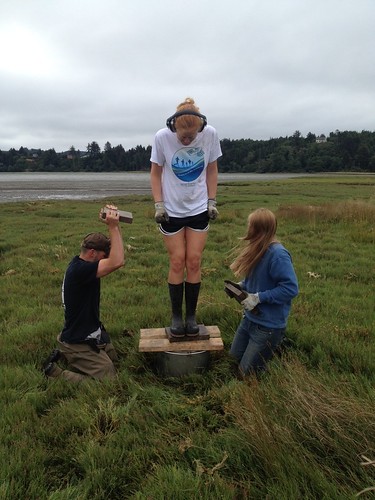My work here in the marshes of Oregon has been challenging in ways I would not have imagined when I applied for the position. Not only have I dealt with the rigors of science in the field, but I have learned a number of survival skills. The picture above shows me using my weight to help with the pounding of the cores. Even though this job does not require physical strength, it does require bravery. (Though I don’t look very brave in this picture!) There is something unnerving about two 40 lbs. weights getting slammed three inches from your feet while two plywood boards holding you up gradually slip apart and the platform beneath you drops an inch each jolt. I have never felt an earthquake before, so perhaps this experience will prepare me a bit.
I have been informed that in the event of an earthquake within twenty miles offshore, the ground at Hatfield Marine Science Center will liquefy and we’ll have a heck of a time getting to high ground before the tsunami hits. My training in the mudflats of Yaquina Bay has given me some preparation for this. Friday we went up river from HMSC to a piece of marsh that had a great stretch of mud we had to cross to get to it. The plan was to take us three interns and the rest of the gear across the mudflat on the hovercraft from the boat. Once we were all piled in, we realized the hovercraft would not move. So Dave, our ever so kind driver, told Taylor and I to get out. Immediately upon stepping out, the mud swallowed Taylor’s leg. I helped pull her out, then walked a few steps away and I started sinking too. It’s a scary feeling being trapped like that. But you have to be patient. If you get too anxious and pull out too fast you can tear your leg muscles and ligaments. Jody, our dedicated lab tech, helped me out then gave me some quick advice for how to walk on mud. Lightly. Just glide across. Walk on the balls of your feet. Don’t stay in one place too long. So I could either stay and wait for the hovercraft to get me and sink possibly further, or charge across the mudflat with my own two feet. I decided the second option. So I made a run for it, sinking in four inches each step, feeling near doing a face plant multiple times. Once across, I was out of breath and exhilarated, having conquered a fear I had all summer!
I have also learned a few other potentially useful non-science skills. I know how to tie a boat to a dock, how to attach the boat to the trailer, and how to operate a jack to most efficiently pull cores out of the ground. It is nice learning to be more handy.
Today we did our last day at Aquarium Marsh, which is sad. I am busy now trying to collect the data into a spreadsheet for my individual project studying the effects of water temperature on nutrient uptake, and finding a way to analyze it and present it. While doing this, we are still continuing the overall project as we travel to Alsea Bay tomorrow and Winant in the Yaquina Thurs and Fri.
This weekend was a great one as my family visited from Seattle and Chicago. We rented a cottage near the beach south of Lincoln City and I got to visit and explore the coast with them. I took my grandpa on an estuary walk given by a fellow scholar, Brian. My grandpa was very adamant about learning everything he could about estuaries as he is a scientist as well, though estuaries are out of his area of expertise. Also, I loved watching my baby nephew toddle along at the beaches we visited. He is great at walking in sand and will one day be a fantastic mudflat walker I’m sure.


